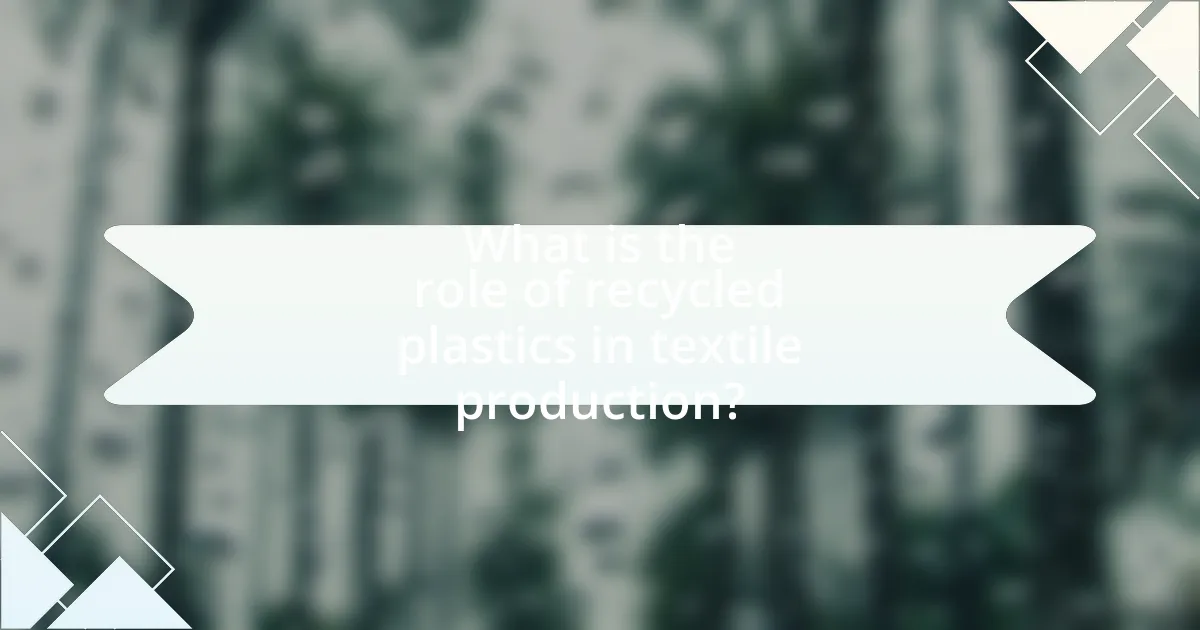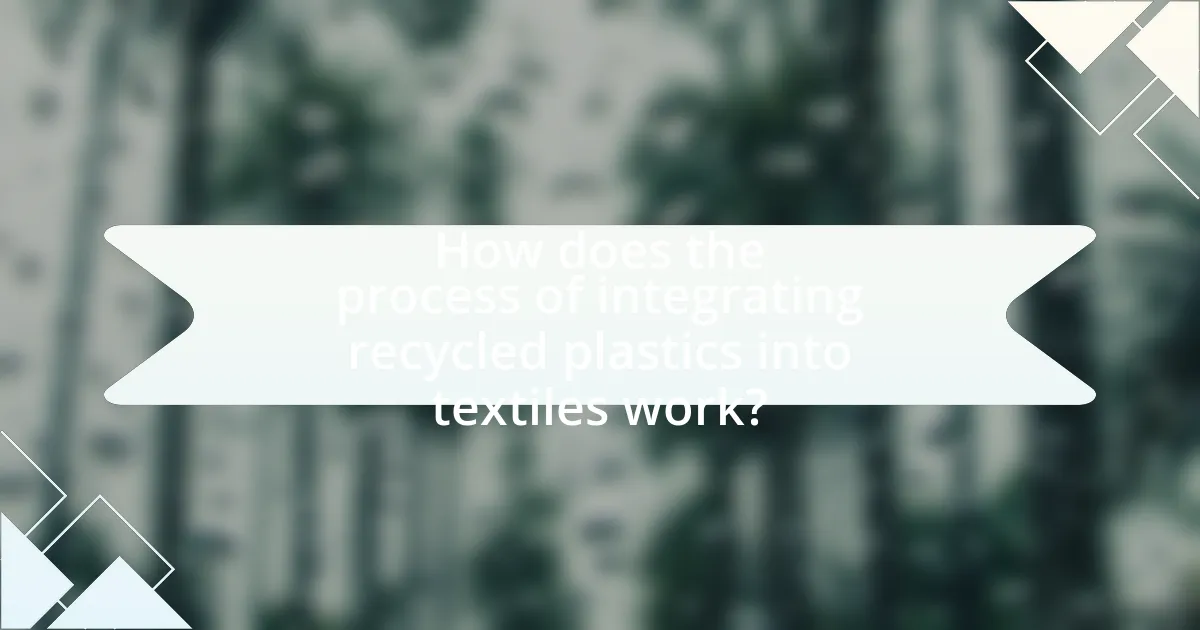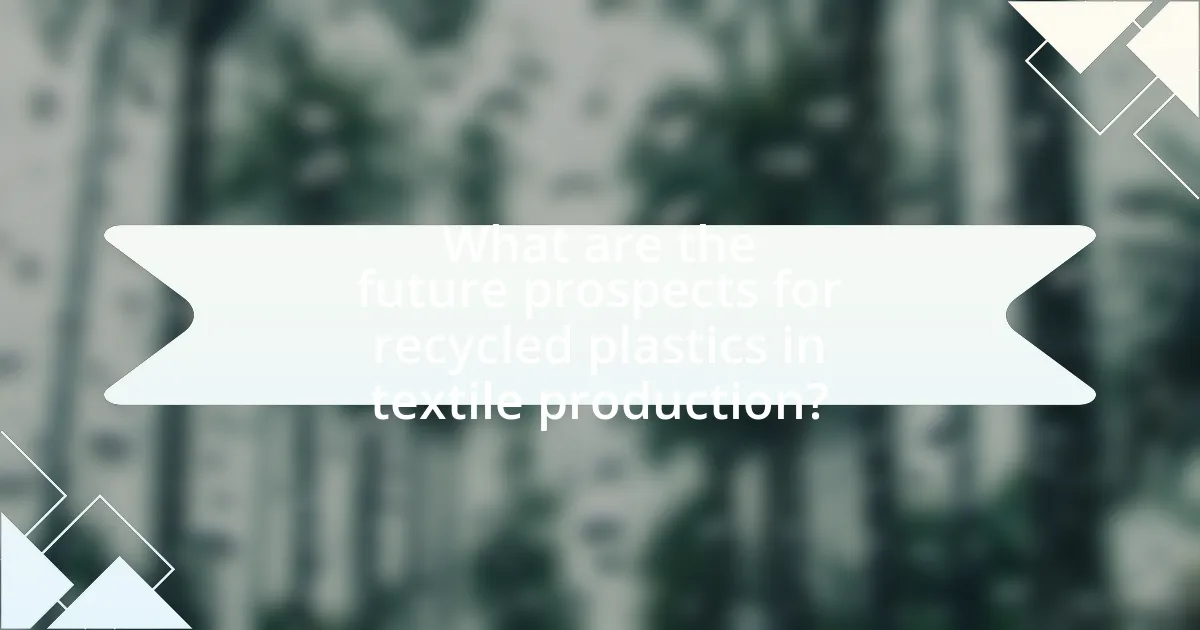The article investigates the role of recycled plastics in textile production, highlighting their significance as a sustainable raw material for creating fibers and fabrics. It details the sourcing of recycled plastics, primarily from post-consumer waste, and outlines the processes involved in transforming these materials into usable textiles. Key types of recycled plastics, such as polyethylene terephthalate (PET) and nylon, are discussed, along with the environmental benefits of using recycled materials, including reduced energy consumption and lower greenhouse gas emissions. The article also addresses challenges related to quality and contamination, while emphasizing the importance of innovation and consumer trends in shaping the future of recycled textiles.

What is the role of recycled plastics in textile production?
Recycled plastics play a crucial role in textile production by serving as a sustainable raw material for creating fibers and fabrics. These plastics, primarily sourced from post-consumer bottles and containers, are processed into polyester fibers, which are then woven or knitted into textiles. According to the Textile Exchange, using recycled polyester can reduce greenhouse gas emissions by up to 32% compared to virgin polyester production. This shift not only conserves resources but also minimizes waste, contributing to a circular economy in the textile industry.
How are recycled plastics sourced for textile manufacturing?
Recycled plastics for textile manufacturing are primarily sourced from post-consumer waste, such as plastic bottles and containers. This waste is collected through recycling programs and initiatives, where it is sorted, cleaned, and processed into usable materials. According to the National Association for PET Container Resources, approximately 1.5 million tons of PET plastic bottles were recycled in the United States in 2020, highlighting the significant volume of available recycled plastics. These processed plastics are then transformed into fibers or pellets, which can be woven or knitted into fabrics for various textile applications.
What types of plastics are commonly recycled for textiles?
Polyethylene terephthalate (PET) and nylon are the most commonly recycled plastics for textiles. PET, often sourced from plastic bottles, is widely used due to its durability and ease of recycling, with approximately 1.5 million tons of PET recycled into textiles annually. Nylon, primarily derived from fishing nets and other waste, is also recycled into fabrics, contributing to sustainable textile production. These plastics are favored for their properties that enhance the performance and longevity of textile products.
What processes are involved in recycling plastics for textile use?
Recycling plastics for textile use involves several key processes: collection, sorting, cleaning, shredding, and extrusion. Initially, plastics are collected from various sources, including post-consumer waste and industrial scraps. Following collection, the materials undergo sorting to separate different types of plastics, typically using automated systems that identify resin types.
Once sorted, the plastics are cleaned to remove contaminants such as labels, dirt, and residues, ensuring the quality of the recycled material. After cleaning, the plastics are shredded into smaller pieces, which facilitates further processing. The shredded plastic is then melted and extruded into fibers, which can be spun into yarn for textile production.
This recycling process is supported by data indicating that recycling plastics can significantly reduce environmental impact; for instance, producing recycled polyester from PET bottles uses up to 75% less energy compared to virgin polyester production.
Why is the use of recycled plastics important in the textile industry?
The use of recycled plastics is important in the textile industry because it significantly reduces environmental impact by minimizing waste and conserving resources. Recycling plastics diverts materials from landfills, where they can take hundreds of years to decompose, and instead repurposes them into valuable textile products. For instance, the production of recycled polyester from plastic bottles can save up to 60% of the energy required to produce virgin polyester, according to the Textile Recycling Association. This process not only lowers carbon emissions but also decreases the demand for new petroleum-based materials, promoting a more sustainable and circular economy in textile production.
What environmental benefits does using recycled plastics provide?
Using recycled plastics provides significant environmental benefits, including reduced waste in landfills and decreased reliance on virgin materials. By recycling plastics, approximately 30% less energy is consumed compared to producing new plastics, which helps lower greenhouse gas emissions. Furthermore, recycling plastics conserves natural resources; for instance, using recycled PET (rPET) in textile production can save up to 60% of the energy required to produce new polyester from petroleum. This process also mitigates pollution, as it reduces the need for plastic production, which is associated with harmful emissions and resource extraction.
How does the use of recycled plastics impact resource conservation?
The use of recycled plastics significantly enhances resource conservation by reducing the demand for virgin materials. Specifically, recycling plastics conserves petroleum resources, as producing new plastics typically requires large quantities of fossil fuels; for instance, recycling one ton of plastic can save approximately 7.4 cubic yards of landfill space and prevent the extraction of about 1.5 tons of oil. Additionally, utilizing recycled plastics in textile production decreases energy consumption, with studies indicating that using recycled polyester can reduce energy use by up to 75% compared to virgin polyester production. This process not only minimizes environmental impact but also promotes a circular economy, where materials are reused, thus preserving natural resources for future generations.
What challenges are associated with using recycled plastics in textiles?
The challenges associated with using recycled plastics in textiles include issues related to quality, contamination, and processing. Quality concerns arise because recycled plastics can have inconsistent properties compared to virgin materials, affecting the durability and performance of the final textile products. Contamination is a significant challenge, as recycled plastics may contain impurities or residues from previous uses, which can compromise the integrity of the textiles. Additionally, the processing of recycled plastics often requires specialized techniques and equipment to ensure proper melting and spinning, which can increase production costs and complexity. These challenges highlight the need for advancements in recycling technologies and quality control measures to enhance the viability of recycled plastics in the textile industry.
What quality issues arise from recycled plastics in textile production?
Quality issues that arise from recycled plastics in textile production include inconsistent fiber quality, contamination, and reduced durability. Inconsistent fiber quality occurs because recycled plastics often come from various sources, leading to variability in properties such as strength and texture. Contamination can happen when non-plastic materials or different types of plastics are mixed, which can affect the final product’s performance and appearance. Additionally, recycled plastics may have lower durability compared to virgin materials, resulting in textiles that wear out more quickly. Studies have shown that these factors can significantly impact the overall quality and marketability of textile products made from recycled plastics.
How do manufacturers address the challenges of using recycled materials?
Manufacturers address the challenges of using recycled materials by implementing advanced processing technologies and establishing robust supply chains. These technologies, such as chemical recycling and improved sorting methods, enhance the quality and consistency of recycled materials, making them more suitable for production. For instance, the use of enzymatic recycling processes can break down plastics into their original monomers, allowing for higher-quality outputs. Additionally, manufacturers often collaborate with suppliers to ensure a steady supply of high-quality recycled inputs, which mitigates variability and enhances product performance. This approach is supported by industry reports indicating that companies utilizing recycled materials can reduce production costs by up to 30% while also meeting sustainability goals.

How does the process of integrating recycled plastics into textiles work?
The process of integrating recycled plastics into textiles involves several key steps, starting with the collection and sorting of plastic waste, primarily PET (polyethylene terephthalate) bottles. After collection, the plastics are cleaned and processed into small flakes or pellets through mechanical recycling methods. These flakes or pellets are then melted and extruded into fibers, which can be woven or knitted into fabric.
For instance, in 2020, the global production of recycled PET fibers reached approximately 1.5 million tons, demonstrating the scale of this integration. The resulting textiles can be used in various applications, including clothing, upholstery, and industrial materials, contributing to sustainability by reducing reliance on virgin materials and minimizing plastic waste in landfills.
What are the steps involved in converting recycled plastics into textile fibers?
The steps involved in converting recycled plastics into textile fibers include collection, sorting, cleaning, shredding, extrusion, and spinning. Initially, recycled plastics are collected from various sources, such as bottles and containers. After collection, the plastics are sorted by type and color to ensure uniformity. The sorted plastics undergo a cleaning process to remove contaminants like labels and residues. Following cleaning, the plastics are shredded into smaller pieces to facilitate processing. The shredded material is then melted and extruded through spinnerets to form continuous filaments. Finally, these filaments are cooled, solidified, and spun into yarn, which can be woven or knitted into textile products. This process effectively transforms waste plastics into usable textile fibers, contributing to sustainable practices in the textile industry.
How is the quality of recycled fibers ensured during production?
The quality of recycled fibers is ensured during production through rigorous sorting, cleaning, and processing methods. These methods involve separating high-quality plastics from contaminants, which is critical for maintaining fiber integrity. Advanced technologies such as infrared sorting and mechanical shredding are employed to enhance the purity of the recycled materials. Additionally, quality control measures, including testing for physical properties and consistency, are implemented throughout the production process to verify that the recycled fibers meet industry standards. This systematic approach helps to ensure that the final product is suitable for textile applications, thereby supporting sustainable practices in the textile industry.
What technologies are used in the transformation of plastics to textiles?
The technologies used in the transformation of plastics to textiles include mechanical recycling, chemical recycling, and biotechnological processes. Mechanical recycling involves shredding plastic waste into small flakes, which are then melted and extruded into fibers for textile production. Chemical recycling breaks down plastics into their monomers or other basic chemicals, allowing for the creation of new fibers with properties similar to virgin materials. Biotechnological processes utilize microorganisms or enzymes to convert plastic waste into biodegradable fibers, offering a sustainable alternative. These methods are supported by advancements in recycling technologies and increasing demand for sustainable textiles, as evidenced by the growth of the recycled polyester market, which reached approximately 5 million metric tons in 2020.
What types of textiles can be produced from recycled plastics?
Recycled plastics can be transformed into various types of textiles, including polyester, nylon, and non-woven fabrics. Polyester made from recycled polyethylene terephthalate (rPET) is commonly used in clothing, upholstery, and outdoor gear, with significant brands like Patagonia and Adidas utilizing this material. Nylon, derived from recycled materials, is often used in activewear and swimwear, providing durability and elasticity. Non-woven fabrics produced from recycled plastics are utilized in applications such as insulation, geotextiles, and disposable products. These textiles contribute to sustainability by reducing plastic waste and conserving resources.
What are the most common applications of recycled plastic textiles?
The most common applications of recycled plastic textiles include clothing, upholstery, and industrial fabrics. Clothing made from recycled plastic, such as t-shirts and activewear, utilizes materials like recycled polyester, which is derived from post-consumer plastic bottles. Upholstery applications often involve the use of recycled textiles in furniture and automotive interiors, providing durability and sustainability. Additionally, industrial fabrics, including geotextiles and tarps, benefit from the strength and weather resistance of recycled plastic materials. These applications demonstrate the versatility and environmental benefits of using recycled plastics in textile production.
How do recycled plastic textiles compare to traditional textiles in performance?
Recycled plastic textiles generally exhibit comparable or superior performance characteristics to traditional textiles. For instance, recycled polyester, derived from plastic bottles, demonstrates high durability, moisture-wicking properties, and resistance to UV light, making it suitable for outdoor and athletic wear. Studies indicate that recycled textiles can maintain similar tensile strength and abrasion resistance as virgin materials, with some research showing that they can outperform traditional fibers in specific applications, such as water resistance and quick-drying capabilities. Additionally, the environmental benefits of using recycled materials contribute to a more sustainable textile industry, reducing reliance on virgin resources and minimizing waste.

What are the future prospects for recycled plastics in textile production?
The future prospects for recycled plastics in textile production are promising, driven by increasing consumer demand for sustainable materials and advancements in recycling technologies. The global market for recycled textiles is projected to grow significantly, with estimates suggesting it could reach $5 billion by 2027, reflecting a compound annual growth rate of over 20%. Innovations in processes such as chemical recycling allow for higher quality fibers from recycled plastics, making them more suitable for various textile applications. Additionally, brands are increasingly committing to circular economy practices, with major companies like Adidas and Patagonia incorporating recycled plastics into their products, further validating the trend.
How is innovation shaping the future of recycled plastics in textiles?
Innovation is significantly shaping the future of recycled plastics in textiles by enhancing the quality, functionality, and sustainability of textile products. Advanced technologies, such as chemical recycling and the development of biodegradable additives, are improving the processing of recycled plastics, allowing for higher-quality fibers that maintain performance characteristics similar to virgin materials. For instance, companies like Unifi have developed Repreve, a brand of recycled fiber made from post-consumer plastic bottles, which has been used in over 30 million garments, demonstrating the scalability and market acceptance of recycled materials. Additionally, innovations in circular economy practices are promoting the integration of recycled plastics into mainstream textile production, reducing waste and resource consumption while meeting consumer demand for sustainable products.
What emerging technologies are enhancing the recycling process?
Emerging technologies enhancing the recycling process include advanced sorting systems, chemical recycling methods, and artificial intelligence (AI) applications. Advanced sorting systems utilize optical sensors and robotics to efficiently separate materials, increasing the purity of recycled inputs. Chemical recycling methods, such as depolymerization, break down plastics into their original monomers, allowing for the creation of high-quality recycled materials. AI applications optimize recycling operations by predicting waste streams and improving operational efficiency, leading to higher recycling rates. These technologies collectively contribute to more effective recycling processes, as evidenced by studies showing that AI can increase recycling efficiency by up to 30%.
How are consumer trends influencing the demand for recycled textiles?
Consumer trends are significantly increasing the demand for recycled textiles as sustainability becomes a priority for consumers. A growing awareness of environmental issues, such as plastic pollution and climate change, has led consumers to prefer products that minimize ecological impact. According to a 2021 survey by McKinsey, 67% of consumers consider sustainability when making purchasing decisions, which directly influences brands to adopt recycled materials in their textile production. This shift in consumer behavior is driving manufacturers to innovate and expand their offerings of recycled textiles, thereby meeting the rising demand for eco-friendly products.
What best practices should manufacturers follow when using recycled plastics in textiles?
Manufacturers should prioritize the use of high-quality recycled plastics that meet industry standards when incorporating them into textiles. This ensures durability and performance, as low-quality recycled materials can compromise the final product’s integrity. Additionally, manufacturers should implement thorough sorting and cleaning processes to remove contaminants, which can affect the quality of the recycled plastics. Research indicates that using properly processed recycled plastics can reduce environmental impact by up to 75% compared to virgin materials. Furthermore, manufacturers should engage in transparent supply chain practices, allowing consumers to trace the origin of recycled materials, thereby enhancing brand trust and sustainability credibility.
How can manufacturers ensure sustainability in their production processes?
Manufacturers can ensure sustainability in their production processes by integrating recycled materials, such as plastics, into their operations. Utilizing recycled plastics reduces the demand for virgin materials, thereby conserving natural resources and minimizing environmental impact. For instance, the Global Recycling Foundation reports that recycling one ton of plastic can save up to 1,000-2,000 gallons of gasoline, highlighting the energy savings associated with using recycled materials. Additionally, manufacturers can adopt energy-efficient technologies and practices, such as using renewable energy sources and optimizing production processes to reduce waste and emissions. Implementing these strategies not only enhances sustainability but also aligns with consumer demand for environmentally responsible products.
What strategies can be implemented to improve the marketability of recycled textiles?
To improve the marketability of recycled textiles, brands can focus on enhancing product quality, increasing consumer awareness, and establishing strong partnerships. Enhancing product quality involves using advanced recycling technologies that maintain or improve the durability and aesthetic appeal of textiles, which can attract more consumers. Increasing consumer awareness through targeted marketing campaigns can educate potential buyers about the environmental benefits and unique qualities of recycled textiles, leading to higher demand. Establishing partnerships with retailers and eco-conscious brands can expand distribution channels and create a more robust market presence. According to a report by the Ellen MacArthur Foundation, the global market for recycled textiles is projected to grow significantly as sustainability becomes a priority for consumers, indicating that these strategies can effectively enhance marketability.

Leave a Reply